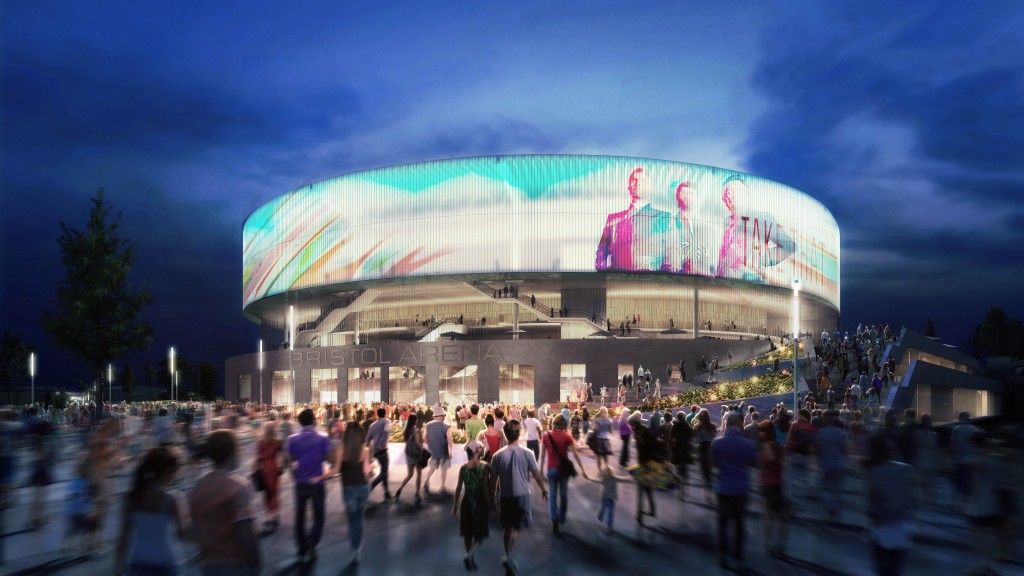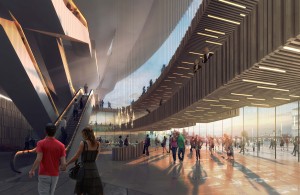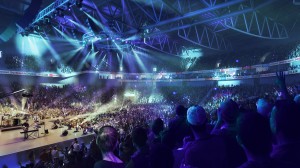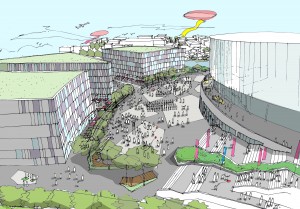 Bristol’s long-awaited arena will be able to host the world’s biggest performers when it opens in less than two years, the team behind the winning design claims.
Bristol’s long-awaited arena will be able to host the world’s biggest performers when it opens in less than two years, the team behind the winning design claims.
Unveiling their plans this week, the team led by architects Populous – designers of the London Olympic Stadium and O2 Arena – insisted the £90m, 12,000 capacity venue will also be the greenest ever built, with a cutting-edge design and featuring state-of-the-art acoustic technology.
Populous senior principal Nicholas Reynolds said: “There is no act touring at the moment that could not play this arena. We want to make it a must-play venue for the entertainment business.”
He said there was no reason the Bristol Arena could not host a major TV event such as the Brits Awards or Sports Personality of the Year. But it will also be able to stage smaller events and during the day could serve as an art or photography gallery. 
Construction work will start on a derelict site next to Temple Meads station – now part of the Temple Quarter Enterprise Zone – next spring, with the building boasting an innovative displacement ventilation system and provision for the biggest building-based photovoltaic system in the city.
It will also help create a new cycle and pedestrian link between the Temple Meads and residential areas to the south and east and draw its electricity from a pioneering local energy scheme planned for the Enterprise Zone.
London-based Populous’ winning elliptical (stretched circle) shaped design was selected from a five-strong shortlist which featured some of the world’s top architects. The brief from Bristol City Council was to ensure it would have an ‘excellent’ rating under the BREEAM assessment system with energy efficiency and low carbon technology built in.
The architects were also told it had to regenerate the surrounding area – now known as Arena Island – and work as a venue for sporting events, family and comedy shows and smaller concerts as well as for major touring acts. “It had to be two arenas in one building,” said Mr Reynolds.
The highly flexible design means seating tiers can be moved around to create different shaped entertainment spaces in the auditorium – from 4,000 seats facing a stage for a spoken-word event to 10,500 seats surrounding a central stage, to the 12,000 capacity for a major act with half the audience standing.
Mr Reynolds said designing the arena also brought the opportunity to create a new cultural and social hub for Bristol.
A plaza outside the arena will act as a venue for events “pre-show and post-show 365 days a year,” he said. “It will be a natural gathering place, full of life and energy. The arena won’t be in isolation – visitors will walk towards it across the busy plaza and really feel they have arrived at their destination.”
From outside, the all-round windows on the upper floors of the arena will be used as a giant electronic billboard for the acts playing inside. The design, said Mr Reynolds, meant the building would not have a front or back but be ‘continuous’ – meaning a ‘wonderful’ view from Bath Road as well as Temple Meads.
“We believe Bristol Arena will be the catalyst for the creation of a vibrant new quarter in the city,” he said. “The design is flexible enough to cater for a wide variety of events and creates a range of spaces inside and out of the venue itself, for people to come together right throughout the year. Our design is unique. It delivers a world-class live concert venue for 12,000 fans, and with seamless conversion the atmosphere and intimacy of a 4,000 seat amphitheatre. The adaptive façade will provide the canvas, which defines the identity of the building within the Bristol skyline, as it transitions between an ephemeral form by day, to a dynamic event backdrop by night.”
Bristol City Council’s arena project team will now work with Populous and other team members – which include Bath firms Feilden Clegg Bradley Architects and Buro Happold Engineering – on the detailed design to be submitted for planning approval in the summer. 
Mayor of Bristol George Ferguson, a past president of the Royal Institute of British Architects, said: “The Populous team has presented an innovative design for a horseshoe-shaped arena that will allow us real flexibility for programming, for now and into the future, offering both performers and audiences an outstanding acoustic and visual experience.
“The new arena shone out as the best of five great designs and will sit comfortably on the Arena Island site next to Temple Meads and Bath Road. I have been determined that we achieve the best arena yet and the commitment towards achieving a BREEAM ‘excellent’ environmental rating adds to Bristol’s reputation as European Green Capital.
“Although Bristol is one of the last cities in the UK to build an arena, this design is an evolution of some the world’s best venues and gave the expert panel real confidence in the team’s ability to deliver a very special venue for the region.”
He said all the funding was in place to build the arena – with money coming through the Government’s City Deal via the Local Enterprise Partnership and from borrowings against future rates in the Enterprise Zone as well as from a management agreement with preferred operators SMG and Live Nation.
“The council should not be out of pocket in 10 to 12 years’ time,” he said.
Mayor Ferguson also said he would love to see Bristol bands such as Massive Attack or Portishead play at the arena – possibly on the first night. ”It would be great to open with a bang,” he said.
The judging panel that selected the winning design included veteran music promoter Harvey Goldsmith – described by Mayor Ferguson as someone who had opened more arenas than anyone else in the industry.
He said: “Bristol needs a fully integrated, multi-use and flexible arena. The winning team have presented a concept that fits the criteria. They understood how an arena works not only from the public’s point of view, but also from the promoter and artist stand point. I think their understanding of the site combined with their knowledge of building arenas made it easy for us to choose this team as the winners. I believe that the new Bristol Arena will rank amongst the best in the UK.”
This week’s milestone in the long-running arena saga was welcomed by Bristol’s property industry.
Jeremy Richards, head of the regional office of property consultancy JLL, said: “Bristol Arena is set to act as a major catalyst for increased inward investment in the city, not least in the Bristol Temple Quarter Enterprise Zone, one of the UK’s largest regeneration projects, of which the arena is a key part.
“We’ve seen the significant benefits this ‘arena effect’ can bring in other regional cities such as Glasgow and Leeds, which saw a boost in investor interest as a result of the opening of their respective arenas in 2013.
“Recent industry rankings showed that Glasgow’s SSE Hydro venue is the world’s second-busiest live entertainment arena and it has hosted major events such as BBC Sports Personality of the Year in 2014 and the 2014 MTV European Music Awards. The ability to host high-profile events such as these will cement Bristol’s place on the global map, highlighting its offering to investors around the world.”






























